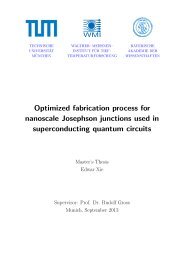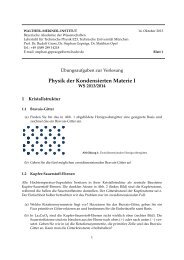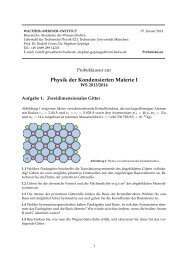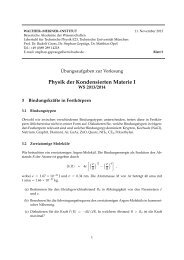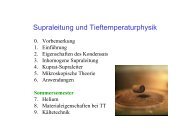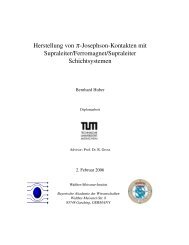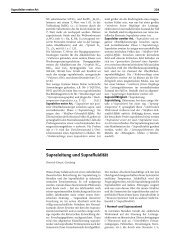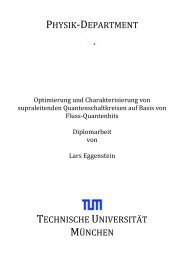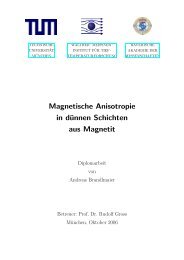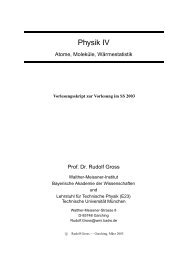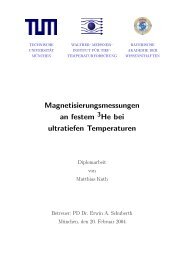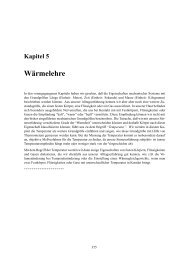Surface magneto-plasmons in magnetic multilayers - Walther ...
Surface magneto-plasmons in magnetic multilayers - Walther ...
Surface magneto-plasmons in magnetic multilayers - Walther ...
Create successful ePaper yourself
Turn your PDF publications into a flip-book with our unique Google optimized e-Paper software.
Section 2.5<br />
Magnetic field dependence of surface <strong>plasmons</strong> 29<br />
(a) (b)<br />
(c)<br />
M<br />
polar longitud<strong>in</strong>al transversal<br />
M<br />
Figure 2.14: Illustration of the Kerr effect geometries with respect to the plane of <strong>in</strong>cidence.<br />
(a) In the polar Kerr effect the magnetization is oriented perpendicular to the<br />
sample surface. (b) The magnetization is parallel to the the sample surface<br />
and parallel to the plane of <strong>in</strong>cidence <strong>in</strong> the longitud<strong>in</strong>al Kerr effect. (c)<br />
In the transversal geometry the magnetization is with<strong>in</strong> the film plane, but<br />
perpendicular to the plane of <strong>in</strong>cidence[57].<br />
These equations show that <strong>in</strong> the transversal geometry there is no polarisation rotation<br />
like <strong>in</strong> the polar and longitud<strong>in</strong>al configuration [59, 57]. The magnetisation (Q) only<br />
<strong>in</strong>fluences the amplitudes of the light waves. Furthermore, magnetisation or <strong>magnetic</strong><br />
field effects will only be seen <strong>in</strong> the p-polarised component, because it is the only<br />
component that depends on Q. In this component the <strong>magnetic</strong> field of the light<br />
wave is parallel (antiparallel) to M.<br />
2.5.2 Change of the dispersion relation of surface <strong>plasmons</strong><br />
Like the Kerr and Faraday effect show, electro<strong>magnetic</strong> waves <strong>in</strong>teract with the mag-<br />
netisation <strong>in</strong> a <strong>magnetic</strong> material. S<strong>in</strong>ce surface <strong>plasmons</strong> are also electro<strong>magnetic</strong><br />
waves there should also be an <strong>in</strong>teraction with the magnetisation or an applied mag-<br />
netic field.<br />
The <strong>in</strong>teraction of surface <strong>plasmons</strong> with an external <strong>magnetic</strong> field was first reported<br />
by Chiu and Qu<strong>in</strong>n [17] and will here be shortly reviewed.<br />
When a <strong>magnetic</strong> field is applied kx is no longer symmetrical, regard<strong>in</strong>g positive and<br />
negative propagation directions. Thus, the lower branch of the dispersion relation<br />
shown <strong>in</strong> Fig. 2.2(b) splits up <strong>in</strong>to two branches, each for every propagation direction<br />
(Fig. 2.15). To calculate the splitt<strong>in</strong>g of the dispersion relation ωB(kx) under an ap-<br />
plied <strong>magnetic</strong> field parallel to the sample surface, the Maxwell equations with the<br />
dielectric tensor have to be solved. S<strong>in</strong>ce Chiu and Qu<strong>in</strong>n use a different notation for<br />
their dielectric tensor, its components for the transversal geometry will be shown.<br />
M



